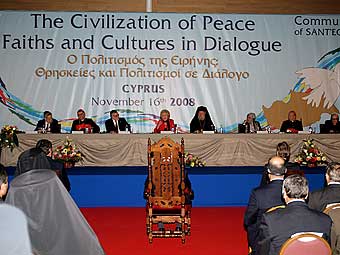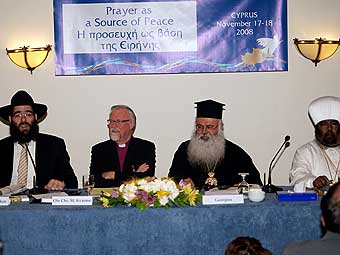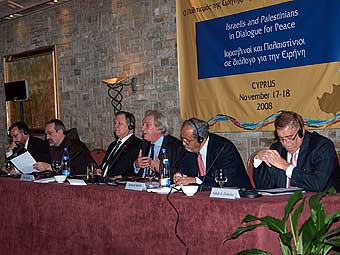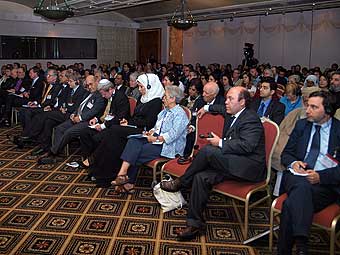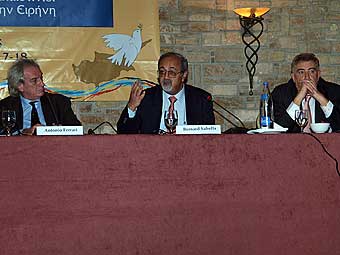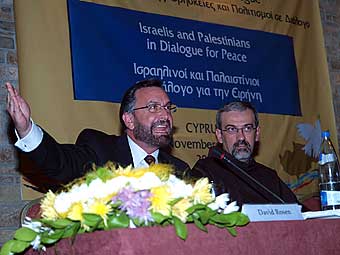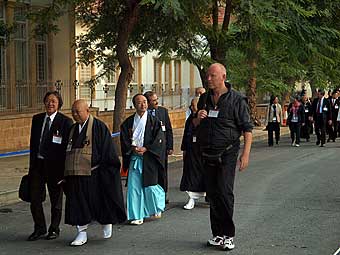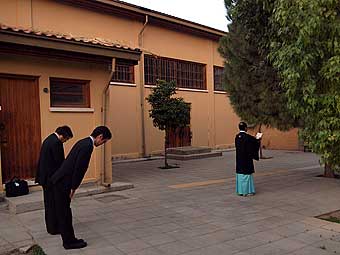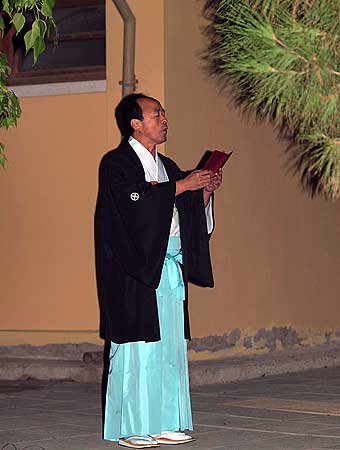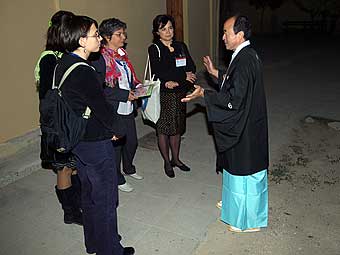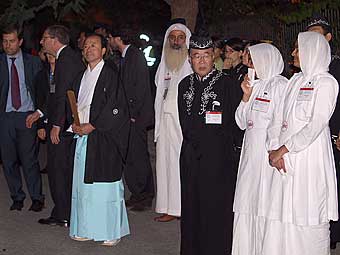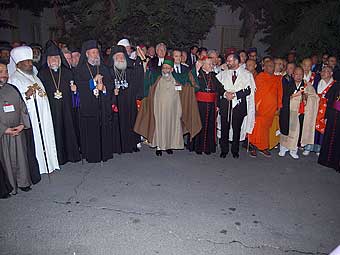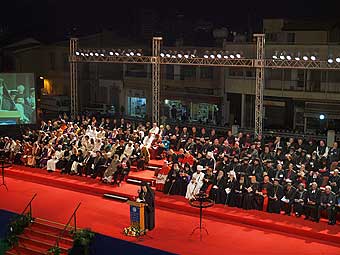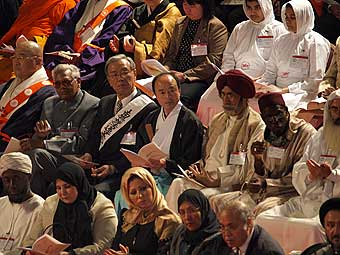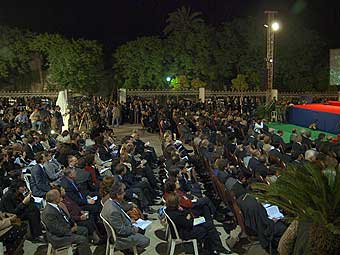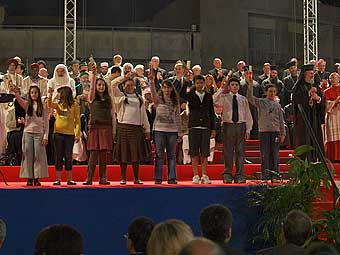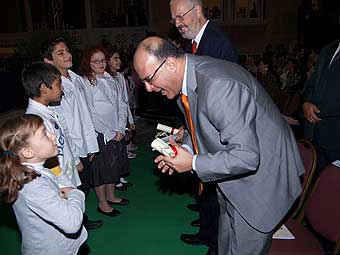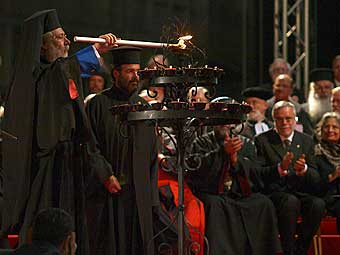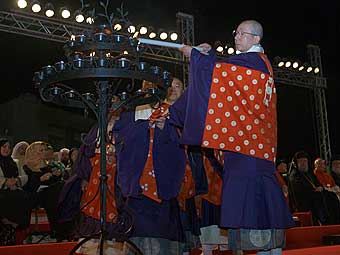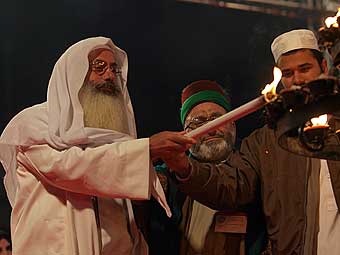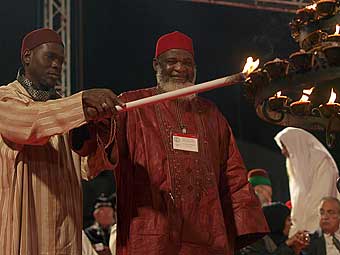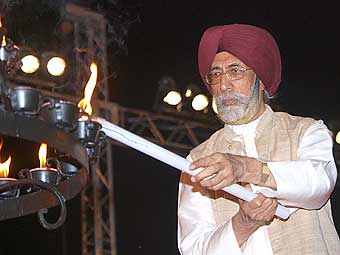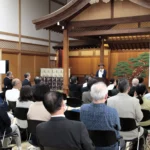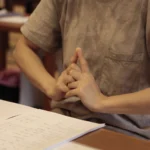Dialogue among religions and cultures
On divided island nation of Cyprus
By Bill Roberts
Nicosia, Cyprus – On a balmy autumn evening, about 200 religious leaders from around the globe prayed for peace, each in their own tradition, and then joined together to make a proclamation for peace, climaxing an interfaith gathering in the ancient capital of this politically divided island in the eastern Mediterranean.
Christians, Muslims, Jews, Hindus, Buddhists, Shintoists and others gathered at dusk for the one hour prayer held at various sites within Nicosia’s walled Old Town. When they finished, the religious leaders, including Reverend Masamichi Tanaka, Chief of the International Department of the Oomoto Foundation, walked to the Archbishopric Yard of the Archbishop of New Justiniana and All Cyprus, for the closing ceremony.
The ceremony on November 18, 2008, brought to a close three days of interfaith talks with the theme of “The Civilization of Peace: Faiths and Cultures in Dialogue.” An audience of several thousand attended the closing, including nearly 1,000 volunteer workers of the Community of Sant’Egidio from Italy and elsewhere, who paid their own way to travel to Cyprus to work to make the event a success.
The Roman Catholic Community of Sant’Egidio cosponsored the conference with the Greek Orthodox Church of Cyprus. The Catholics and the Orthodox split nearly two millennia ago. When the late Pope John Paul II began to promote interfaith dialogue more than two decades ago, he first emphasized the need to bring these two groups closer together. Later, he pressed for reconciliation with Judaism and Islam, the two other major monotheistic religions.
‘A school of peace and dialogue’
Professor Andrea Riccardi, founder of the Community of Sant’Egidio, emphasized the continuing importance of dialogue during his address at the closing ceremony.
“The wind of peace is a gift of God. But men, women, peoples do have a great responsibility: there is much they can do. It is what we learned in Cyprus during these days, that there is a school of peace and dialogue,” Riccardi said. “The medicine of dialogue can heal conflicts. Dialogue does not require war and violence, but listening and talking. Dialogue reveals that the use of force and war is not inevitable. … Nothing is lost with dialogue; anything can be achieved through dialogue.”
As part of the closing, a peace proclamation was read, and then signed by each religious leader. About 30 Cypriot children mounted the stage, received copies of the declaration, and presented them to government leaders sitting in the front row of the audience.
The Community of Sant’Egidio began conducting interfaith conferences more than 20 years ago. Founded in 1968, the Rome-based community is a worldwide movement of more than 50,000 Catholic lay people dedicated to living according to the teachings of Jesus, and to interreligious dialogue, peace, justice and service to humankind. Most of the members volunteer in programs aimed at helping the poor and marginalized people. The community is involved in many such efforts, including literacy, AIDs prevention, and an initiative to have the death penalty banned in all nations.
The community gained worldwide acclaim for helping to negotiate an end to the long civil war in Mozambique, and has been nominated more than once for the Nobel Peace Prize. In 1999, the Community of Sant’Egidio was awarded the prestigious Niwano Peace Prize by the Niwano Peace Foundation of Japan.
The universality of religion
The community held its first interfaith gathering in 1986 in Assisi, Italy, attended by Pope John Paul II. Oomoto priests attended the first event, and have attended most the annual conferences since then, including one held in Washington, D.C., and those held in Lyons, Milan, Rome, Bucharest, Warsaw and elsewhere in Europe. Next year’s event will be held in Cracow, Poland.
Oomoto’s participation in these and other interreligious activities is based on its doctrine of Bankyo Dokon, expressed by Co-Founder Onisaburo Deguchi. Bankyo Dokon loosely translates as “all religions spring from the same source.” Oomoto means “the great source,” or “the great origin.” Because Oomoto believes that all religions come from the same universal god, its members actively work for interreligious prayer and dialogue among religions within Japan and those outside.
A panel of distinguished religious and political leaders addressed the opening ceremony of the Cyprus conference on November 16 in the Sports Centre of the University of Cyprus. Among them were Dimitris Christofias, president of the Republic of Cyprus. Among the other speakers Shear-Yashuv Cohen, Chief Rabbi of Haifa, Israel. Rabbi Cohen visited Oomoto more than 15 years ago for a World Federation meeting.
During his keynote at the opening, Chrysostomos II, Archbishop of New Justiniana and All Cyprus, noted the universality of the issues examined during the three days of talks:
“Peace is a universal value and the attainment of its true content is the ultimate objective of any religion. If some fail to achieve it, these are individual people or nations that are influenced by baser values and ideals, and not the religions or cultures which seek perfection and prioritize their values correctly. All religions accept that peace and war are born in the hearts of men, because the heart – in the non-religious sense of the word – is the core of the human being, the place where bonds with other people are created. Peace is born in the heart of people who are reconciled with God, who are cleansed of all passions and pettiness.”
An unresolved divided nation
Cyprus is the last divided nation in Europe, with Cypriots yearning for a resolution of the dispute. Following a period of turmoil in the early 1970s between the Greek and Turkish communities on the small island (population 2 million), the Turkish army invaded in 1974. The United Nations eventually brokered a ceasefire, but Turkey retains control of about 40 percent of the island. The border runs through Old Town in Nicosia.
The now peaceful, but still unresolved dispute never seemed far removed from the conference proceedings. In his keynote address at the opening, Riccardi said: “Cyprus stands on a history of coexistence between two ethnic groups and religious communities. But for several decades now it has been the last patch of occupied Europe. Cyprus has experienced the pain of division, the sorrows of hatred and absence of dialogue.”
In his keynote at the opening, Archbishop Chrysostomos II alluded to the divided land, but said this was never a religious conflict between the Greek Orthodox and the Turkish Muslims. The two communities have lived in peace and tolerance for centuries, he said. The turmoil grew out of non-religious ethnic and political disputes.
Over the next two days, about two dozen panel discussions were held. Religious leaders, scholars, political leaders, and others exchanged ideas on a host of topics including the role of religion in democracy, the role of religion in solving poverty, religious freedom, religion and culture, religion and terrorism, religion’s role in stopping genocide, and the role of religion in the globalized world.
Reverend Tanaka of Oomoto participated in a panel discussion on coexistence and the role of religions in Asian. Other panelists included Tomokazu Hatakeyama, deputy secretary general of the World Conference of Religions for Peace in Japan; Gensho Hozumi of Rinzai Zen Buddhism in Japan; and Masahiko Iburi, director of the Tenrikyo Headquarters in Japan.
Another conflict not far removed from Cyprus is the Israeli-Palestinian dispute, and it was also heavily on people’s minds during the conference. In one of the more provocative panel discussions, religious and political leaders – Jews, Muslims and Christians – attempted to shed some light on the situation there.
One of the more interesting exchanges came between the two Israelis on the panel, one a political leader and the other religious. The political leader was Meir Sheetrit, Israel’s Minister of the Interior, and the religious leader was Rabbi David Rosen, chairman of the International Jewish Committee on Interreligious Consultations, a broad-based coalition of Jewish organizations representing World Jewry to other religions. Rosen has visited Oomoto in the past.
Sheetrit and Rosen disagreed passionately on the role of religion in bringing a resolution between Israelis and Palestinians. Sheetrit argued that ultra-religious Jews had been an obstacle to efforts to negotiate peace, while Rosen argued that the government needed the more moderate religious groups as a partner for peace.
